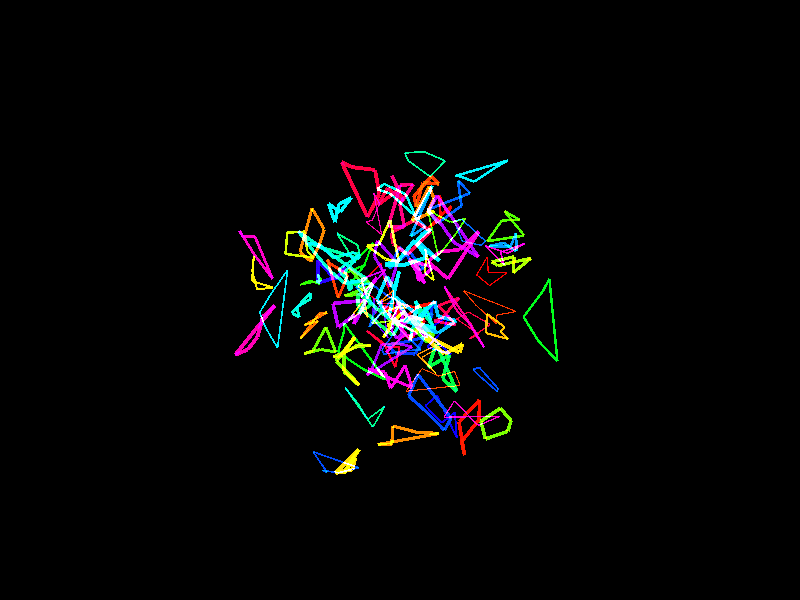Line Effect
Learning Zig programming language …
Line effect for learning zig’s struct random and raylib implementation ect.

const rl = @cImport({
@cDefine("SUPPORT_GIF_RECORDING", "1");
@cInclude("Raylib.h");
});
const std = @import("std");
const math = std.math;
const rand = @import("rand.zig");
const MAX_LINE_COUNT = 5;
const MAX_THICKNESS = 3.0;
const MAX_LIFE_SPAN = 20.0;
const MAX_LINE_LENGTH = 50.0;
pub const LinePath = struct {
pos: rl.Vector2,
speed: rl.Vector2,
color: rl.Color,
thickness: f32,
points: [MAX_LINE_COUNT]rl.Vector2,
count: usize,
lifeSpan: f32,
timer: f32,
pub fn init(pos: rl.Vector2) LinePath {
var lp: LinePath = undefined;
lp.pos = pos;
lp.speed = .{ .x = rand.float32() * 2.0 - 1.0, .y = rand.float32() * 2.0 - 1.0 };
lp.color = rl.ColorFromHSV(rand.float32() * 360.0, 1.0, 1.0);
lp.thickness = rand.float32() * MAX_THICKNESS + 1.0;
lp.points[0] = lp.pos;
for (1..MAX_LINE_COUNT) |i| {
const x: f32 = rand.float32() * 40.0 + lp.points[i - 1].x;
const y: f32 = rand.float32() * 40.0 + lp.points[i - 1].y;
lp.points[i] = .{ .x = x, .y = y };
}
lp.count = MAX_LINE_COUNT;
lp.lifeSpan = MAX_LIFE_SPAN * @as(f32, @floatFromInt(MAX_LINE_COUNT));
lp.timer = 0.0;
return lp;
}
pub fn draw(self: *LinePath) void {
rl.DrawLineEx(self.pos, self.points[0], self.thickness, self.color);
for (0..self.count - 1) |i| {
rl.DrawLineEx(self.points[i], self.points[i + 1], self.thickness, self.color);
}
}
pub fn update(self: *LinePath) void {
self.timer += 1;
if (self.timer < self.lifeSpan) {
self.pos.x += self.speed.x + rand.float32() * MAX_LINE_LENGTH - 25.0;
self.pos.y += self.speed.y + rand.float32() * MAX_LINE_LENGTH - 25.0;
pushPoints(self, self.pos);
} else {
if (self.count > 1) {
popPoints(self);
} else {
const pos: rl.Vector2 = .{ .x = 400.0, .y = 300.0 };
reset(self, pos);
}
}
}
fn pushPoints(self: *LinePath, pt: rl.Vector2) void {
if (self.count == MAX_LINE_COUNT) {
popPoints(self);
self.points[self.count] = pt;
self.count = self.count + 1;
} else {
self.points[self.count] = pt;
self.count = self.count + 1;
}
}
fn popPoints(self: *LinePath) void {
for (0..self.count - 1) |i| {
self.points[i] = self.points[i + 1];
}
self.count = self.count - 1;
}
fn reset(self: *LinePath, pos: rl.Vector2) void {
self.timer = 0.0;
self.pos = pos;
self.speed = .{ .x = rand.float32() * 2.0 - 1.0, .y = rand.float32() * 2.0 - 1.0 };
self.color = rl.ColorFromHSV(rand.float32() * 360.0, 1.0, 1.0);
self.thickness = rand.float32() * MAX_THICKNESS + 1.0;
self.points[0] = self.pos;
for (1..MAX_LINE_COUNT) |i| {
const x: f32 = rand.float32() * 40.0 + self.points[i - 1].x;
const y: f32 = rand.float32() * 40.0 + self.points[i - 1].y;
self.points[i] = .{ .x = x, .y = y };
}
self.count = MAX_LINE_COUNT;
self.lifeSpan = MAX_LIFE_SPAN * @as(f32, @floatFromInt(MAX_LINE_COUNT));
}
};